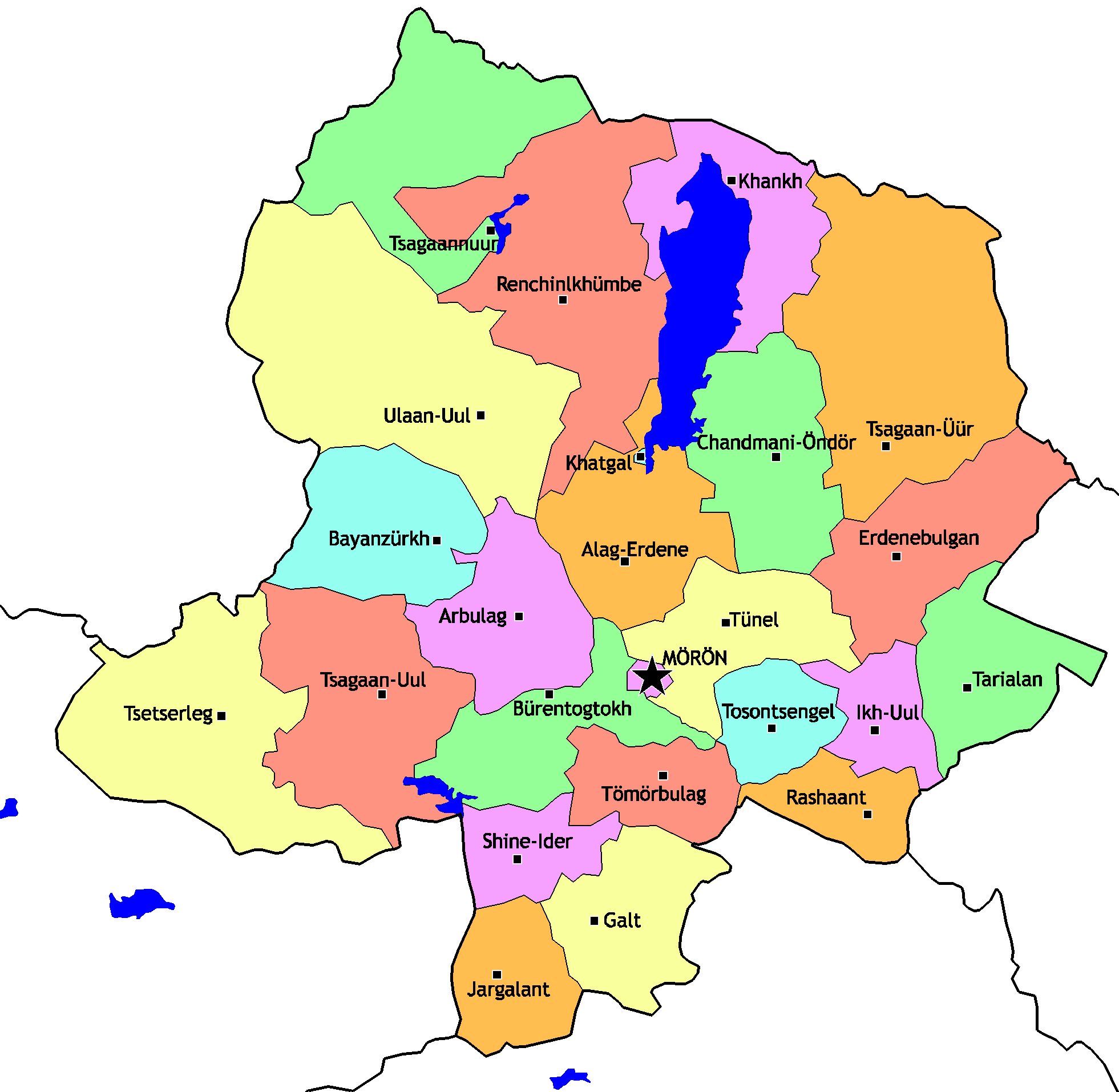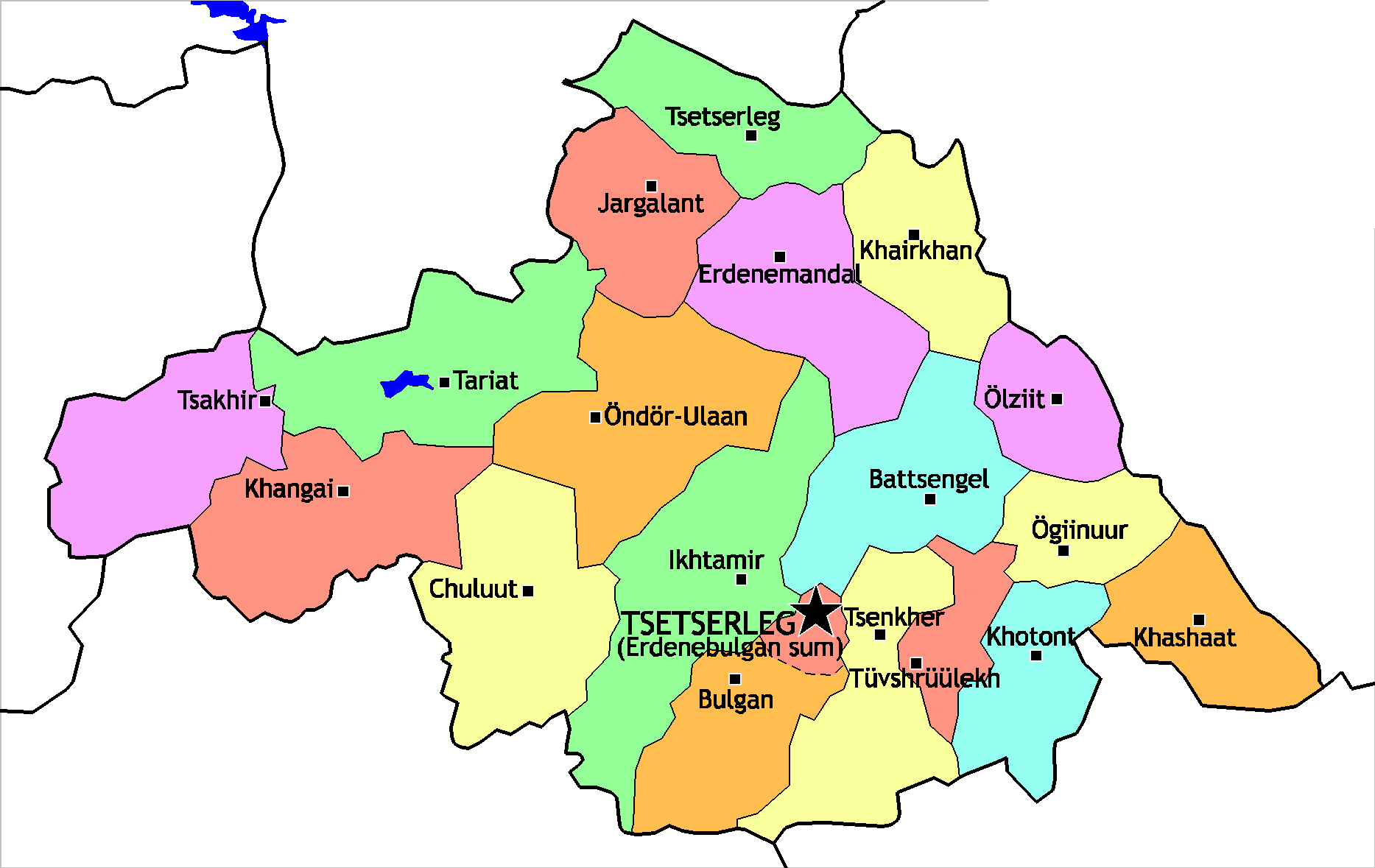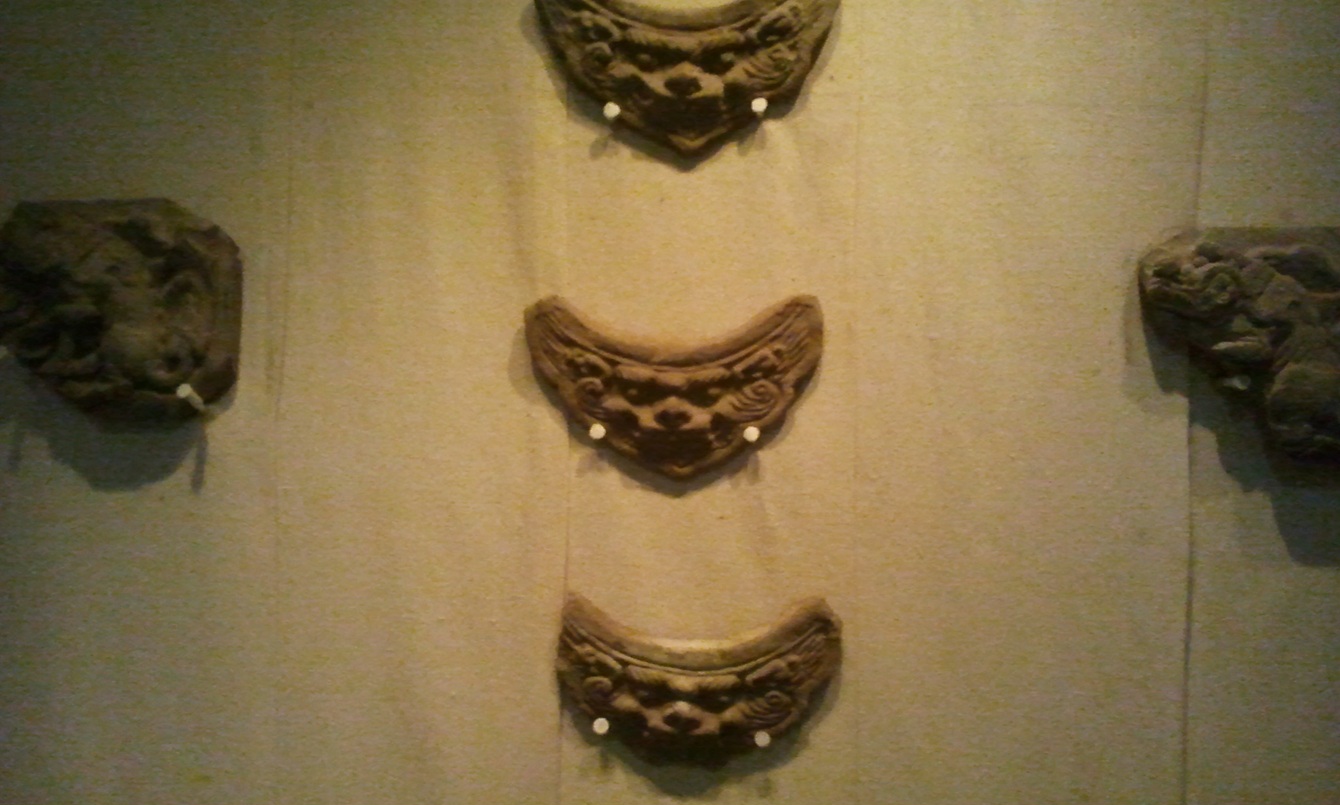|
Tsetserleg, Khövsgöl
Tsetserleg ( mn, Цэцэрлэг, ''lit. "garden"'') is a sum of Khövsgöl aimag, Mongolia. The area is 7,480 km2, of which 6,040 km2 are pasture and 1,340 km2 are forest. 15 km2 are farmland. In 2000, Tsetserleg had a population of 5,876 people, mainly Khotgoid. The sum center, officially named ''Khalban'' ( mn, Халбан), is located 209 km west of Mörön and 880 km from Ulaanbaatar. History A Tsetserleg sum was formed from parts of the Khantaishir uulyn aimag's Delgerkhaan uulyn khoshuu in 1930. In 1931, some bags were added, and in 1933, Tsetserleg sum had roughly 3,800 inhabitants in 1150 households, and 92,000 heads of livestock. In 1954, the local Enkh-Amidral negdel was founded. Economy In 2004, there were about 110,000 heads of livestock, among them 45,000 goats, 48,000 sheep, 8,300 cattle and yaks, 8,100 horse The horse (''Equus ferus caballus'') is a domesticated, one-toed, hoofed mammal. It belongs to the taxonomic ... [...More Info...] [...Related Items...] OR: [Wikipedia] [Google] [Baidu] |
Districts Of Mongolia
A district ( mn, сум, , , ; "arrow"), is a second level administrative subdivision of Mongolia. The 21 Provinces of Mongolia are divided into 331 districts.Montsame News Agency. ''Mongolia''. 2006, Foreign Service office of Montsame News Agency, , p. 46 On average, each district administers a territory of with about 5,000 inhabitants, primarily nomadic herders. Its total revenue is 120 million Tögrög, 90% of which comes from national subsidies. Each district is again subdivided into ''bags'' (brigades; sometimes spelled ''baghs''). Most bags are of an entirely virtual nature. Their purpose is to sort the families of nomads in the district into groups, without a permanent human settlement. Officially, and occasionally on maps, many district seats (sum centers) bear a name different from that of the district. However, in practice the district seat (sum center) is most often referred to under the name of the district, to the point of the official name of the district se ... [...More Info...] [...Related Items...] OR: [Wikipedia] [Google] [Baidu] |
Countries Of The World
The following is a list providing an overview of sovereign states around the world with information on their status and recognition of their sovereignty. The 206 listed states can be divided into three categories based on membership within the United Nations System: 193 member states of the United Nations, UN member states, 2 United Nations General Assembly observers#Present non-member observers, UN General Assembly non-member observer states, and 11 other states. The ''sovereignty dispute'' column indicates states having undisputed sovereignty (188 states, of which there are 187 UN member states and 1 UN General Assembly non-member observer state), states having disputed sovereignty (16 states, of which there are 6 UN member states, 1 UN General Assembly non-member observer state, and 9 de facto states), and states having a political status of the Cook Islands and Niue, special political status (2 states, both in associated state, free association with New Zealand). Compi ... [...More Info...] [...Related Items...] OR: [Wikipedia] [Google] [Baidu] |
Mongolia
Mongolia; Mongolian script: , , ; lit. "Mongol Nation" or "State of Mongolia" () is a landlocked country in East Asia, bordered by Russia to the north and China to the south. It covers an area of , with a population of just 3.3 million, making it the world's most sparsely populated sovereign nation. Mongolia is the world's largest landlocked country that does not border a closed sea, and much of its area is covered by grassy steppe, with mountains to the north and west and the Gobi Desert to the south. Ulaanbaatar, the capital and largest city, is home to roughly half of the country's population. The territory of modern-day Mongolia has been ruled by various nomadic empires, including the Xiongnu, the Xianbei, the Rouran, the First Turkic Khaganate, and others. In 1206, Genghis Khan founded the Mongol Empire, which became the largest contiguous land empire in history. His grandson Kublai Khan conquered China proper and established the Yuan dynasty. After the co ... [...More Info...] [...Related Items...] OR: [Wikipedia] [Google] [Baidu] |
Provinces Of Mongolia
A province is almost always an administrative division within a country or state. The term derives from the ancient Roman ''provincia'', which was the major territorial and administrative unit of the Roman Empire's territorial possessions outside Italy. The term ''province'' has since been adopted by many countries. In some countries with no actual provinces, "the provinces" is a metaphorical term meaning "outside the capital city". While some provinces were produced artificially by colonial powers, others were formed around local groups with their own ethnic identities. Many have their own powers independent of central or federal authority, especially in Canada and Pakistan. In other countries, like China or France, provinces are the creation of central government, with very little autonomy. Etymology The English word ''province'' is attested since about 1330 and derives from the 13th-century Old French , which itself comes from the Latin word , which referred to the sphere ... [...More Info...] [...Related Items...] OR: [Wikipedia] [Google] [Baidu] |
Khövsgöl Province
Khövsgöl ( mn, Хөвсгөл) is the northernmost of the 21 aimags (provinces) of Mongolia. The name is derived from Lake Khövsgöl. Geography and history The round-topped Tarvagatai, Bulnain and Erchim sub-ranges of the Khangai massif dominate the south and southwest of the largely mountainous province, and north and west of Lake Khövsgöl, lie the alpine Khoridol Saridag, Ulaan Taiga, and Mönkh Saridag mountains. The center and eastern parts of the province are less mountainous, but still hilly. The region is well known in Mongolia for its natural environment, and Lake Khövsgöl is one of the country's major tourist attractions. The largest forests of Mongolia are located around and to the north of the lake, extending the South Siberian taiga. The aimag was founded in 1931. Khatgal was the administrative center until 1933; since then it has been Mörön. Population The region is home to many ethnic minority groups: Darkhad, Khotgoid, Uriankhai, Buriad, and Tsaat ... [...More Info...] [...Related Items...] OR: [Wikipedia] [Google] [Baidu] |
Sums Of Mongolia
A district ( mn, сум, , , ; "arrow"), is a second level administrative subdivision of Mongolia. The 21 Provinces of Mongolia are divided into 331 districts.Montsame News Agency. ''Mongolia''. 2006, Foreign Service office of Montsame News Agency, , p. 46 On average, each district administers a territory of with about 5,000 inhabitants, primarily nomadic herders. Its total revenue is 120 million Mongolian tögrög, Tögrög, 90% of which comes from national subsidies. Each district is again subdivided into ''bags'' (brigades; sometimes spelled ''baghs''). Most bags are of an entirely virtual nature. Their purpose is to sort the families of nomads in the district into groups, without a permanent human settlement. Officially, and occasionally on maps, many district seats (sum centers) bear a name different from that of the district. However, in practice the district seat (sum center) is most often referred to under the name of the district, to the point of the official name ... [...More Info...] [...Related Items...] OR: [Wikipedia] [Google] [Baidu] |
Khotgoid
Khotogoid ( Mongolian: Хотгойд, transliteration: ) is a subgroup of Mongol people in northwestern Mongolia. The Khotogoid people live roughly between Uvs Lake to the west and the Delgermörön river to the east. The Khotogoids belong to northwestern Khalkha and were one of the major groups that make up Khalkha. The best-known ruler of Khotogoids probably was Ubashi Huang Taizi, also known as Altan Khan of the Khotogoid (not to be confused with Altan Khan of Tumed) who was successful in subjecting Yenisei Kirghiz and pushing Oirats out of their domains in western Mongolia. The northern border of the Khotgoid Khanate reached modern Russian Krasnoyarsk city and the southern border reached the eastern Altay Mountains of Mongolia in the 17th century. The Khotogoid Khanate was not an independent state and its ruler was subject to Zasagt khan aimag of Khalkha. In mid 17th century, because of the conflicts with neighboring Zasagtu Khan, the Khotogoids disintegrated and cease ... [...More Info...] [...Related Items...] OR: [Wikipedia] [Google] [Baidu] |
Mörön (city)
Mörön ( mn, Мөрөн;, lit=river), also spelled Murun, is the administrative center of Khövsgöl Aimag (province) in northern Mongolia. Before 1933, Khatgal had been the aimag capital. It has 12,286 families and a population of 46,918, and is considered a major city such as Ulaanbaatar, Darhan, Erdenet and Choibalsan. In terms of administrative units, it is divided into 14 khoroo and covers approximately 102.9 km2. Demographics are split as 51.58% females to 48.42% males. 41.25% of the population is aged between 15 and 39. Although a poorly developed town, Mörön has a hospital, a museum, a theatre, a post office, nine schools and fifteen kindergartens. It was connected to the Mongolian central power grid in 2004. The town has had a paved road connecting it to Mongolia's capital city Ulaanbaatar since December 2014, as a part of a government effort to extend paved roads from Ulaanbaatar to all Aimag capitals. History The settlement stems from the Möröngiin Khu ... [...More Info...] [...Related Items...] OR: [Wikipedia] [Google] [Baidu] |
Ulaanbaatar
Ulaanbaatar (; mn, Улаанбаатар, , "Red Hero"), previously anglicized as Ulan Bator, is the capital and most populous city of Mongolia. It is the coldest capital city in the world, on average. The municipality is located in north central Mongolia at an elevation of about in a valley on the Tuul River. The city was originally founded in 1639 as a nomadic Buddhist monastic center, changing location 28 times, and was permanently settled at its current location in 1778. During its early years, as Örgöö (anglicized as Urga), it became Mongolia's preeminent religious center and seat of the Jebtsundamba Khutuktu, the spiritual head of the Gelug lineage of Tibetan Buddhism in Mongolia. Following the regulation of Qing-Russian trade by the Treaty of Kyakhta in 1727, a caravan route between Beijing and Kyakhta opened up, along which the city was eventually settled. With the collapse of the Qing Empire in 1911, the city was a focal point for independence efforts, leading ... [...More Info...] [...Related Items...] OR: [Wikipedia] [Google] [Baidu] |
Banner (Inner Mongolia)
A banner (, as "khoshun" in Mongolian) is an administrative division of the Inner Mongolia Autonomous Region in China, equivalent to a county-level administrative division. Banners were first used during the Qing dynasty, which organized the Mongols into banners except those who belonged to the Eight Banners. Each banner had sums as nominal subdivisions. In Inner Mongolia, several banners made up a league. In the rest, including Outer Mongolia, northern Xinjiang and Qinghai, Aimag (Аймаг) was the largest administrative division. While it restricted the Mongols from crossing banner borders, the dynasty protected Mongolia from population pressure from China proper. After the Mongolian People's Revolution, the banners of Outer Mongolia were abolished in 1923. There were 49 banners and 24 tribes in Inner Mongolia during the Republic of China. Today, banners are a county-level division in the Chinese administrative hierarchy. There are 52 banners in total, include 3 a ... [...More Info...] [...Related Items...] OR: [Wikipedia] [Google] [Baidu] |
Negdel
Negdel ( mn, Нэгдэл, "union, association") is the common term for the agricultural cooperatives in the Mongolian People's Republic. The full name is Khödöö aj akhuin negdel ( mn, Хөдөө аж ахуйн нэгдэл = ''Agricultural association''). History Early attempts The first attempts at agricultural collectivization in the Mongolian People's Republic were made in 1930-32, but failed miserably. Mongolia's livestock population decreased by around a third and the forceful manner in which collectivization was conducted lead to uprisings that could only be quelled with the help of the Soviet Union. Introduction of the negdel New attempts at collectivization were begun with different tactics and another name - the cooperatives in the early 1930s had been called khamtral, i.e. ''collective, kolkhoz'' - in the mid-1930s, but initially only on a very small scale: while there were 139 negdels country-wide in 1950,H.Barthel, ''Mongolei - Land zwischen Taiga und W� ... [...More Info...] [...Related Items...] OR: [Wikipedia] [Google] [Baidu] |
Goat
The goat or domestic goat (''Capra hircus'') is a domesticated species of goat-antelope typically kept as livestock. It was domesticated from the wild goat (''C. aegagrus'') of Southwest Asia and Eastern Europe. The goat is a member of the animal family Bovidae and the tribe Caprini, meaning it is closely related to the sheep. There are over 300 distinct breeds of goat.Hirst, K. Kris"The History of the Domestication of Goats".''About.com''. Accessed August 18, 2008. It is one of the oldest domesticated species of animal, according to archaeological evidence that its earliest domestication occurred in Iran at 10,000 calibrated calendar years ago. Goats have been used for milk, meat, fur, and skins across much of the world. Milk from goats is often turned into goat cheese. Female goats are referred to as ''does'' or ''nannies'', intact males are called ''bucks'' or ''billies'', and juvenile goats of both sexes are called ''kids''. Castrated males are called ''wethers''. Whil ... [...More Info...] [...Related Items...] OR: [Wikipedia] [Google] [Baidu] |







